When mentioning data, one would normally think of a laboratory report. When it comes to the assessment, analyses and evaluation process, however, observations and records from the farm are equally important.
Although methods vary in degree of sophistication, the results are of equal importance in the process. A simple observation, such as feeling the grittiness of the deposits in the pipelines, is of no less importance than determining the concentration of sodium using an ICP costing R1 million.
The majority of the data required in a management system to assess, analyse and evaluate water quality management is generated on the farm. Analyses by outside facilities are limited to the analyses of the water itself and sometimes deposits found in the system. These analyses are mostly used to confirm on-farm analyses and observations.
Usually, the water quality manager (WQM) has little say in the quality of the water received on the farm. The quality is good, marginal or poor. The task of the WQM is to improve those water quality factors that can be improved and manage the others to minimise their impact on profitability and the environment.
In general, water quality factors impact the irrigation system, soil productivity and crop production. The challenge is to decide when to take action to eliminate the factors and when to manage the impact. The framework for all these decisions is the profitability of production in a sustainable environment.
Effects of Physical Water Quality Factors
The main effect of the physical water quality factors (PWQF) is blocking or clogging of the emitters. The standard set by the Department of Water Affairs and Forestry (DWAF, 1996) for the clogging hazard of water is as follows:

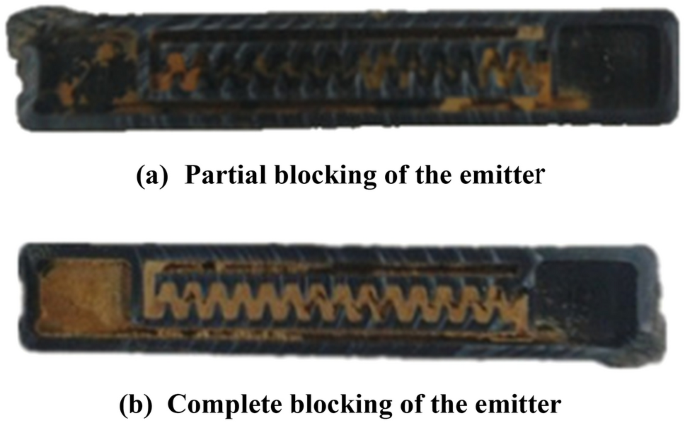
Apart from the PWQF the chemical (CWQF) and microbiological (MWQF) factors also contribute to the clogging of emitters. These can be tabulated according to DWAF as follows.
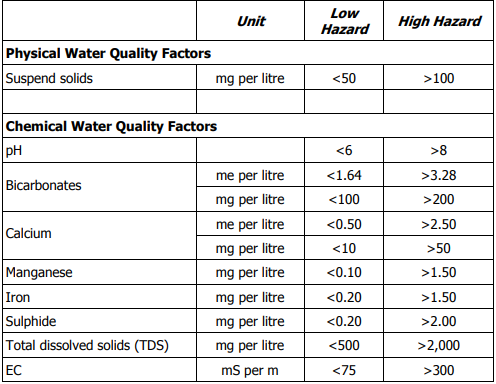

Note: The following conversion factors apply to the units of the table above:
me per litre = mg per litre / equivalent weight Equivalent weight = atomic weight/ charge of the ion
The effects of clogged emitters are so devastating on production that water classified as having a Low Clogging Hazard still needs treatment because some of these factors have a cumulative effect on the irrigation system. Therefore, apart from the initial analysis of the water, continuous monitoring of these factors in the piping and emitters is essential.
The above classification needs adjustment based on the hazard that can be caused by the accumulation in the pipes. The assessment is done as in the example below:

The rate of accumulation of suspended solids as well as the agglomerating effect of the bacteria will depend on a number of factors, including temperature, the flow rate in the pipes, temperature, etc. The requirement should be included in the specifications for the filtration system. This forms part of an irrigation system design and a filtration system should be installed with the capacity to handle the load of solids for the specific water.
Effects of Chemical Factors
Assessing, analysing and evaluating data relating to the chemical water quality factors and determining the best course for corrective action are much more complicated than is the case with data relating to physical water quality factors.
Certain chemical factors cannot be corrected economically, and the water quality manager can only take steps to limit the impact on production and the environment. The type of irrigation system used, i.e., micro-jets or drippers, also have an influence on the actions that can be taken to correct and/or minimise the impact.

Corrective actions include those to improve the CWQF and those to reduce the impact on the environment and on crop production.
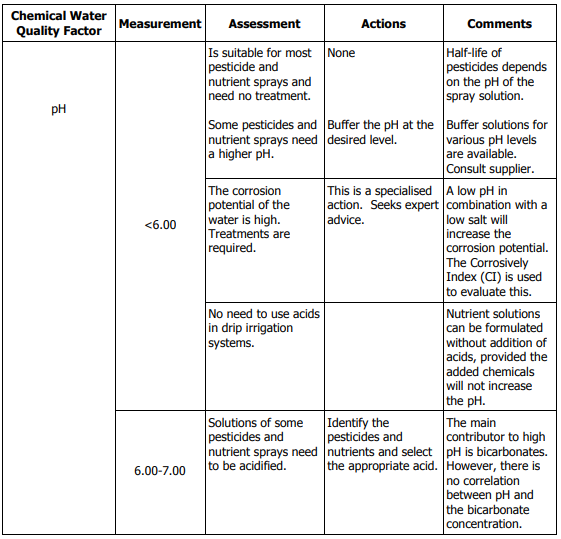
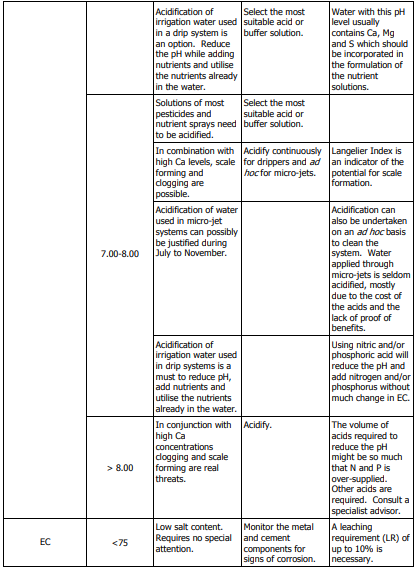
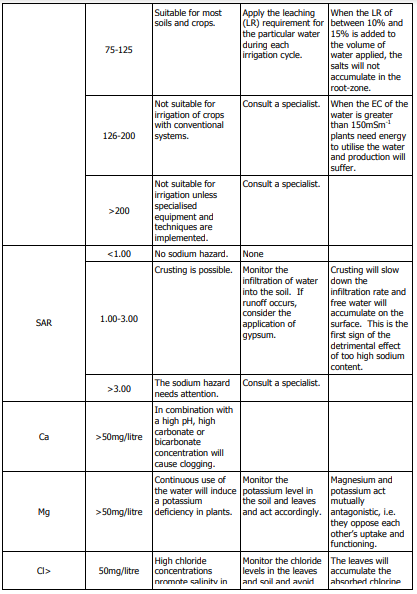
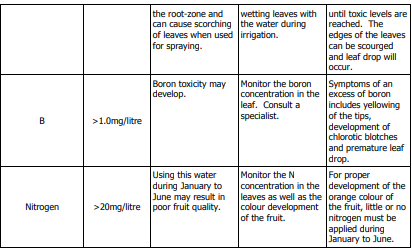
Buffer Solution
Buffer solutions have the ability to absorb or release protons (hydrogen or acid ions) in a solution in order to keep the pH constant. Buffers have a limited pH range and different buffers must be used to buffer the pH at various levels.
Chlorosis and Necrosis
Chlorosis is the yellowing of local areas on a leaf. This is usually the first sign of a detrimental incidence in or on the leaf. The cells are not dead and sometimes the reaction can be reversed. Necrosis is the step following chlorosis when the cell die and brown areas or spots appears on and in the leaf. Negrosis is irreversible.
Apart from the salts in the water that can cause clogging, salts added as fertilisers can also aggravate the clogging hazard.

Effects of Microbiological and Biological Factors
In fruit production, the microbiological and biological water quality factors (BWQF) are limited to those that promote the growth of bacteria and slimes in the piping after filtration. The bacterial and slime growth act as agglomerating agents to bind other suspended material into lumps that will block the emitters. The growth is aggravated by the addition of nitrogen, phosphorus and organic carbon (molasses, organic acids or buffers). Applying nutrient solutions through the irrigation system will stimulate the growth of the microbes.
Treatment is applied before, during or after filtration. The best results are however obtained when the complete system (filters, supply lines, laterals and emitters) is disinfected. Drip irrigation systems need continuous disinfection. This decision should be based on historical data and current analyses, including those of the deposits in the piping and emitters.
Although DWAF indicates that less than 10,000 organisms per ml pose a low clogging hazard, the bacteria multiply in the pipes and any number will eventually clog the emitters. The bacteria population in the system must be monitored continuously and action taken accordingly. The most effective method to determine the presence of the different microbes is to evaluate the deposits in the pipes when flushing the system.
Principles and Use of Operational Technical Systems
The technical systems involved in water quality management are so closely related to the irrigation and fertigation systems that they are usually also managed by the irrigation manager. These include the filtration, acid and disinfectant applicators. Only under extreme conditions will such technical systems be managed by the water quality manager.
Dosing Apparatus
Acidification and disinfection are done by using the same equipment as for applying fertilisers. The selection and operation of these systems form part of the irrigation program. The equipment consists mainly of dosing apparatus which will introduce acid or chlorine into the irrigation water. Two groups of dosing equipment are available (Koegelenberg & Conradie, 2000).
Passive dosing apparatus: This group includes apparatus that sucks the acid or chlorine solution into the stream of water in the pipes. This can be done at the suction end of the irrigation pump, a venture system, or a pressure tank connected to the irrigation system.
Using the irrigation pump for dosing: The reservoir with acid or chlorine is connected to the intake end and the chemicals are sucked into the system in the same way as the water. The volume can be regulated by a tap. This is a simple and cheap method, but the acid and chemicals may damage the pump.
Using a venturi for dosing: The venturi is fitted in the pipeline. When water flows through the venture, a localised drop in pressure is caused. The container with the chemicals is connected to the area of decreased pressure and the chemicals are forced into the pipeline by atmospheric pressure and carried by the water. The rate of intake can be regulated.
Using a pressurised tank for dosing: A tank is connected at two points to the irrigation pipe. Between the two connecting points, a valve or tap is fitted to create higher pressure at the first point. The water flows through the tank and, due to the lower pressure at the second point, re-enters the pipeline on its way to the trees.
Active Dosing Apparatus
This group represents all the types of pumps that are used to force the solutions of the chemicals into the pipeline. These include pumps utilising centrifugal forces, screws, diaphragms, pistons, peristalsis and gears to force the chemical solutions into the irrigation system.
Filtration equipment: The filtration system forms an integral part of the irrigation system, but the type and capacity depend on the quality of the irrigation water. Three types of filtration systems are available.
Mesh or screen filters: Mesh filters are made of stainless steel or nylon compounds. The size of the openings and the total mesh area determine the capacity of the filter. Mesh filters are used to filter the water of good quality but that contains sand and silt. It is not suitable to remove algae from the water.
The mesh number refers to the number of cross wires per square inch that create the openings.

Ring or disc filters: Ring filters have a three-dimensional filtering action and a higher capacity than mesh filters for the same measurements. The filter unit consists of a number of flat plastic discs with grooves on the flat side. When packed together in a cylinder, they form a surface with small channels from the outside to the inside of the cylinder. Water is filtered when it flows from the outside to the inside of a cylinder through this maze of tiny grooves. Ring filters are cleaned by backwashing when water flows from the inside to the outside of the cylinder.
Sand Filters: Sand filters remove organic and inorganic material, but not suspended clay particles, from the water. It is also a three-dimensional system with a high capacity. The particle sizes of the sand used are specified to remove suspended solids with a diameter of as small as 80 microns (0.08 mm). The lower the flow rate through the sand filter, the better the filtration. Sand filters are always used in conjunction with a disc or mesh filter.